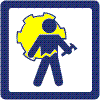|
traumatic
occupational injury
|
Logging Safety |
|
|
The Lumber and Wood Products Industry (LWPI) ranks as one of the most hazardous. The Logging Industry, as a major component of the LWPI, evidences a greater frequency rate and severity rate for injuries than any other industrial component of the LWPI. Consequently, there is a clearly established need for determining priorities of efforts intended to make this occupation less hazardous. (From Worker Safety in Logging Operations). |
|
NIOSH Publications on Logging Safety: Bell, JL, Helmkamp JC. 2003. Non-fatal injuries in the West Virginia logging industry: Using workers' compensation claims to assess risk from 1995 through 2001. American Journal of Industrial Medicine 44(5):502-509. Wang J, Bell JL, Grushecky ST. 2003. Logging injuries for a 10-year period in Jilin Province, People's Republic of China. Journal of Safety Research 34(3):273-279. Bell JL. 2002. Changes in logging injury rates associated with use of feller-bunchers in West Virginia. Journal of Safety Research 33:463-471. Helicopter Logging Safety: Alaska Interagency
Working Group for the Prevention of Occupational Injuries (DHHS
(NIOSH) Pub. No. 98-147) July 1998. (Currently not available
online) Fosbroke DE, Myers JR. 1996. Logging safety and forest management education - A necessary link. J FOREST 94 (7): 21-25. (Currently not available online) Myers JR, Fosbroke DE. 1995. The Occupational Safety and Health Administration Logging Standard: what it means for forest managers. Journal of Forestry. November:34-37. (Currently not available online) NIOSH Alert: Request for Assistance in
Preventing Injuries and Deaths of Loggers (DHHS (NIOSH) Pub. No.
95-101) May 1995. Myers JR, Fosbroke DE. 1994. Logging fatalities in the United States by region, cause of death, and other factors - 1980-1988. J Safety Res 25:97-105. Fosbroke DE, Myers JR,.1992. Interpreting logging injury statistics. Paper No. 92-7509. 1992 International Winter Meeting, American Society of Agricultural Engineers, Nashville, TN, 15-18 Dec. 1992. (Currently not available online) Job Injuries Among Loggers (DHHS (NIOSH)
Pub. No. 83-104) January 1983. (Currently not available online) Worker Safety in Logging Operations (HEW
(NIOSH) Pub. No. 74-103) April 1974. (Currently not available
online) NIOSH Criteria for a Recommended Standard:
Logging from Felling to First Haul (HEW (NIOSH) Pub. No. 76-188)
July 1976. Fatality Investigation Reports (conducted
under the FACE Program) NIOSHTIC-2
Database - Search for additional NIOSH articles on Logging.
Other NIOSH Publications related to logging safety: Identifying High-Risk Small Business
Industries: The Basis for Preventing Occupational Injury, Illness,
and Fatality: NIOSH Special Hazard Review (DHHS (NIOSH) Pub. No.
99-107) May 1999. Occupational Mortality in Washington
State, 1950-1989 (DHHS (NIOSH) Pub. No. 96-133) March 1997. NIOSH Alert: Request for Assistance in
Preventing Electrocutions of Workers Using Portable Metal Ladders
Near Overhead Power Lines (DHHS (NIOSH) Pub. No. 89-110) July 1989. NIOSH Alert: Request for Assistance in
Preventing Fatalities of Workers Who Contact Electrical Energy (DHHS
(NIOSH) Pub. No. 87-103) December 1986.
Other pages of interest: OSHA Technical Link for Logging Safety
|
|
| Traumatic Occupational Injury Home |

